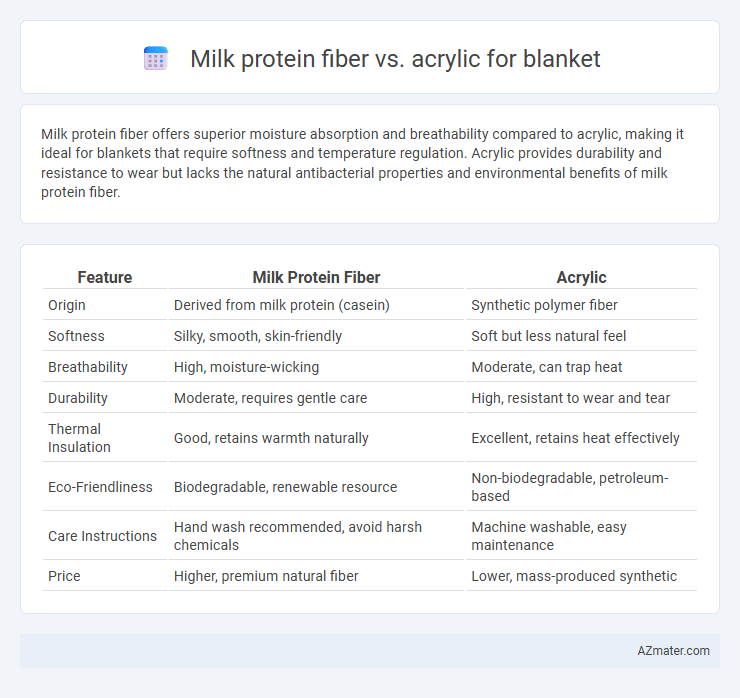Milk protein fiber offers superior moisture absorption and breathability compared to acrylic, making it ideal for blankets that require softness and temperature regulation. Acrylic provides durability and resistance to wear but lacks the natural antibacterial properties and environmental benefits of milk protein fiber.
Table of Comparison
| Feature | Milk Protein Fiber | Acrylic |
|---|---|---|
| Origin | Derived from milk protein (casein) | Synthetic polymer fiber |
| Softness | Silky, smooth, skin-friendly | Soft but less natural feel |
| Breathability | High, moisture-wicking | Moderate, can trap heat |
| Durability | Moderate, requires gentle care | High, resistant to wear and tear |
| Thermal Insulation | Good, retains warmth naturally | Excellent, retains heat effectively |
| Eco-Friendliness | Biodegradable, renewable resource | Non-biodegradable, petroleum-based |
| Care Instructions | Hand wash recommended, avoid harsh chemicals | Machine washable, easy maintenance |
| Price | Higher, premium natural fiber | Lower, mass-produced synthetic |
Introduction to Blanket Materials: Milk Protein Fiber vs Acrylic
Milk protein fiber blankets offer natural hypoallergenic properties, moisture-wicking abilities, and enhanced softness, making them ideal for sensitive skin and sustainable textile choices. Acrylic blankets provide durability, vibrant color retention, and affordability, commonly used for their easy maintenance and resistance to wrinkles and moths. Comparing thermal insulation and eco-friendliness highlights milk protein fiber as a biodegradable alternative to traditional synthetic acrylic fibers in blanket manufacturing.
What Is Milk Protein Fiber?
Milk protein fiber is a natural, biodegradable textile made from casein protein found in milk, offering softness and moisture-wicking properties ideal for blankets. Compared to acrylic, a synthetic fiber derived from petroleum, milk protein fiber provides better breathability and hypoallergenic benefits, enhancing comfort and skin-friendliness. Blankets made from milk protein fiber are eco-friendly, renewable, and provide natural temperature regulation, making them a sustainable alternative to acrylic blankets.
Understanding Acrylic Fiber for Blankets
Acrylic fiber for blankets is a synthetic material known for its lightweight, softness, and resistance to moisture and mildew, making it a popular alternative to natural fibers. It offers excellent warmth retention and durability, often mimicking the feel of wool while being more affordable and easier to care for. Compared to milk protein fiber, acrylic lacks natural antimicrobial properties but delivers superior colorfastness and faster drying times, which enhances its appeal in blanket manufacturing.
Eco-Friendliness and Sustainability Comparison
Milk protein fiber, derived from natural milk casein, offers a biodegradable alternative to synthetic acrylic, reducing environmental impact through easier decomposition and less microplastic pollution. Acrylic, a petroleum-based synthetic fiber, has a higher carbon footprint and contributes significantly to non-biodegradable waste in landfills and oceans. Choosing milk protein fiber for blankets supports sustainability by lowering resource consumption, promoting renewable materials, and enhancing eco-friendly textile practices.
Softness and Comfort: User Experience
Milk protein fiber blankets offer exceptional softness due to their natural proteins that mimic human skin, providing a smooth and silky texture ideal for sensitive skin. Acrylic blankets, although warm and lightweight, tend to have a slightly coarser feel and may cause static, which can reduce overall comfort. Users consistently report that milk protein fiber blankets deliver a more luxurious and cozy experience, enhancing comfort and softness compared to traditional acrylic options.
Warmth and Insulation Properties
Milk protein fiber offers superior warmth and insulation for blankets due to its natural ability to regulate temperature and retain heat, making it ideal for cold climates. This eco-friendly fiber has excellent moisture-wicking properties that keep the skin dry, enhancing overall thermal comfort. In contrast, acrylic provides decent insulation but tends to trap heat less efficiently and can retain moisture, potentially reducing its effectiveness in maintaining consistent warmth.
Durability and Maintenance Requirements
Milk protein fiber blankets exhibit high durability due to their moisture-wicking and antimicrobial properties, allowing them to maintain softness and structural integrity over time. Acrylic blankets offer strong resistance to wear and tear with good color retention, but they may be more prone to pilling and static buildup. Maintenance for milk protein fiber blankets typically involves gentle washing and air drying to preserve fiber quality, whereas acrylic blankets can be machine washed and dried but may require more frequent care to manage pilling and maintain appearance.
Allergy and Skin Sensitivity Considerations
Milk protein fiber is hypoallergenic and naturally antibacterial, making it ideal for individuals with sensitive skin or allergies, as it reduces the risk of irritation and allergic reactions. Acrylic fibers, while synthetic and less breathable, can sometimes cause skin irritation or discomfort for those with heightened sensitivity due to their chemical composition. Choosing milk protein fiber blankets ensures a gentle, moisture-wicking option that promotes skin health compared to the potentially irritating nature of acrylic materials.
Cost Comparison: Milk Protein Fiber vs Acrylic
Milk protein fiber blankets typically cost more than acrylic ones due to natural fiber processing and eco-friendly benefits that drive higher production expenses. Acrylic blankets are generally more affordable, benefiting from synthetic fiber mass production and lower material costs, making them a budget-friendly option. The higher durability and softness of milk protein fiber can justify its elevated price, while acrylic offers cost-effective warmth and easy maintenance.
Which Blanket Material Is Best for You?
Milk protein fiber blankets offer natural softness, excellent moisture-wicking properties, and hypoallergenic benefits, making them ideal for sensitive skin and eco-conscious consumers. Acrylic blankets provide durability, affordability, and resistance to wrinkles and moths, suitable for budget-friendly, easy-care options. Choosing the best blanket material depends on your priorities for comfort, sustainability, and maintenance requirements.

Infographic: Milk protein fiber vs Acrylic for Blanket
 azmater.com
azmater.com